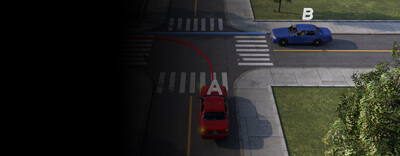Driving Tests for Teens
State-specific questions
Questions closely resembling the official DMV test


Questions closely resembling the official DMV test



The most common minimum age for acquiring a driver's license is 16, though some states require drivers to be older.
Most states require teenagers to obtain a learner's permit before testing for a driver's license. These permits allow teens, ages 14-18 depending on the state, to operate a vehicle in the company of a licensed driver. In most states, teens must pass a written road knowledge test to secure a permit.
State-specific laws dictate how long a teen driver must hold a learner's permit before they can test for a driver's license. Some states require a certain amount of supervised hours logged behind the wheel, while others require teen drivers to take a driver's education course.
Once a teen driver gets a learner's permit, it's finally time to get behind the wheel. This can be exciting or scary, but either way, new drivers will need to ease into it. Over time, driving can become second nature, but for teens who are unfamiliar with the sensitivity of a gas pedal, the time it takes to stop, or how to use a mirror when merging, driving is anything but easy. The following are some tips for staying safe while learning to drive.
A parking lot won't prepare a young driver for the road, but it's a great place for teens to familiarize themselves with the car's controls and how it feels to drive. New drivers can get a feel for the car in an empty parking lot by driving straight, reversing, turning and learning the important controls like blinkers, windshield wipers, and headlights. A parking lot is also a great place to learn how to use your mirrors and backup camera.
Once a teen driver feels ready for the road, you'll want to find a slow, lightly trafficked spot to begin. Subdivisions and roads with low-speed limits (under 35 MPH) are good options. These roads should not have many pedestrians on them.
Teenage drivers should spend as much time as they need driving exclusively on quiet roads to get a feel for braking distance and maintaining lane position. Once drivers feel comfortable controlling the car, they can move up to heavier trafficked roads with speed limits of 35-45 MPH.
You don't want to hop on the interstate right away. Finding small highways with speed limits of 55 MPH in your area is a better strategy. Parents and/or teachers of teen drivers should find lightly trafficked spots where drivers can learn to merge and change lanes safely.
Avoid driving in rush hour traffic until comfortable and confident operating the vehicle. Teen drivers should practice keeping a safe distance from surrounding cars, reading road signs, overtaking and being passed, and maintaining a safe and legal speed while driving on the highway.
Teenagers might know they're ready to take their road test once they feel comfortable driving on all roads, in all scenarios. Parents will also likely have an instinct about whether or not their teens are ready to take on driving solo.
Here are some questions to ask yourself when deciding if your teen is ready to obtain a driver's license and drive on their own:
Prepare yourself for the DMV exam with our free driving tests.
Select your state